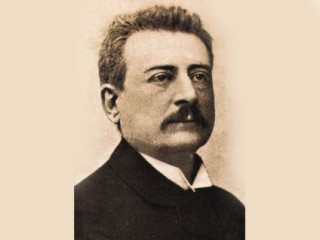
Temistocle Calzecchi-Onesti biography
Date of birth : 1853-12-14
Date of death : 1922-11-25
Birthplace : Lapedona, Italy
Nationality : Italian
Category : Science and Technology
Last modified : 2010-06-03
Credited as : Physicist and inventor, ,
1 votes so far
Temistocle Calzecchi Onesti was Italian physicist and inventor who demonstrated in experiments carried out between 1884 and 1886 that metal filings contained in an insulating tube will conduct an electrical current under the action of an electromagnetic wave.
This property disappears if the tube is shaken. This phenomenon was used by Edouard Branly and by Marconi in the coherer – one of the first receivers of electromagnetic waves used in wireless telegraphy.
In 1884 Temistocle Calzecchi Onesti, a teacher in the lyceum of Fermo, observed that loosely packed metallic powders are bad electricity conductors until subjected to some external forces such as electric sparks generated by the opening and closing of an electrical circuit, or the presence of inductive fields , or by electrostatic induction. He also noticed the influence of electrical discharges of athmosferic perturbations on the iron filing.
When this device, later called coherer, was subjected to the influence of a radio wave (and such is the electromagnetic field produced by a spark), probably because of microscopic electric arcs that weld together adjoining metal particles, an electric current can flow from one electrode to the other.
In other words the coherer acts like a kind of semi-conductor device, something like a triac or an SCR, where the trigger is a radio wave instead of a current applied to the gate. In later times others went over his discovery and finally applied it to the detection of coded signals such as Morse coded radio broadcasts.
Amongst them English Sir Oliver Lodge who provided the name for the device and in 1890 explained the principle of the micro-welds, the French Branly, the Russian Popov, and finally Guglielmo Marconi who in 1894, ten years later, made his first experiments on wireless telegraphy using a three-sparks Righi oscillator powered by a Ruhmkorff machine and of course, in the receiver, a coherer connected to the aerial and acting as an off-on switching device.
The Poldhu broadcast of 1901 went through a coherer… The wireless was born! Other than that, the coherer has been employed as a storm and earthquake forecaster.
Device for detecting radio waves designed in 1890 by Edouard Branly on the basis of observations undertaken by Temistocle Calzecchi-Onesti between 1884 and 1886. The coherer is made up of a small tube containing iron filings, with two discs of metal acting as conductors at the ends of the tube, connected to an electrical circuit.
In normal conditions, the resistance of the tube is quite high, since it contains large quantities of air, so an electrical current will not pass through. However, when an electromagnetic wave of radio frequency goes through the tube, its resistance decreases greatly, and it becomes a conductor.
This means that an electrical current will be switched on and that the coherer can be used to reveal the existence of electromagnetic waves. Marconi produced improved versions of the device and for many years it continued to be the best instrument for telling whether there were electromagnetic waves in the vicinity.
















